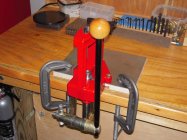I've had good experience using drafting table covers for the top of a reloading bench - provides a smooth, flexible surface to work on. Cleanup is easy as well. If it gets real dirty, say from spent primer residue that gets ground in, a wipe with Naptha and its like new again.
I use these for my workbench and lathe table in the garage as well.
I use these for my workbench and lathe table in the garage as well.











